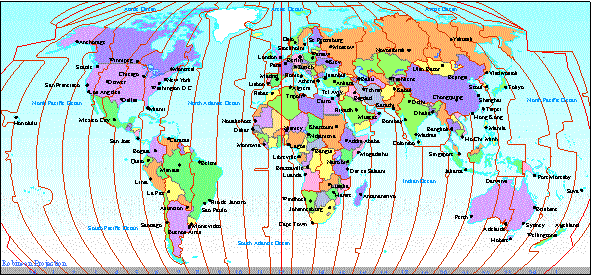Time and Seasons
Time Zones
The time zone in which we live is really a local time zone. The reason that we have a local time zone is because everyone likes to see the sun rise about 6:30-7 am and set 6-7 pm.
To achieve this and have a system for others to know our time zone we have to appreciate the use of World Time. World time is called either GMT or UTC. GMT is the most common name and is short for Greenwich Mean Time. Greenwich is a suburb of London U.K..... Longitude of 0 degrees passes through Greenwich.
The reason for this is historical, based on the world's first accurate time device. Until the 1770s East-West navigation over long distances was not particularly accurate because of lack of accurate timekeeping. Latitude, ie North-South, was reasonably accurate because of the access of the sun.
Earth Rotation
Earth Seasons
Time zones

The world spins on its axis every 24 hours. There are 360 degrees in a circle. If you divide 24 into 360 you get 15. Hence every 15 degrees of Longitude is worth one hour. The reference is 0 degrees at the Greenwich meridian of Longitude.
Every 15 degrees East of Greenwich is an hour ahead of GMT because the sun rises in the East. The opposite applies to West Longitude. Honolulu is approximately 155 degrees West, hence the local time zone is 10 hours behind GMT. Sydney, Australia, is approximately 155 degrees East, so the local time zone there is 10 hours ahead of GMT.
Many places around the world add an hour for daylight savings to make better use of the sun for up to six months. It is only necessary to know where and when this applies to calculate the local time zone.